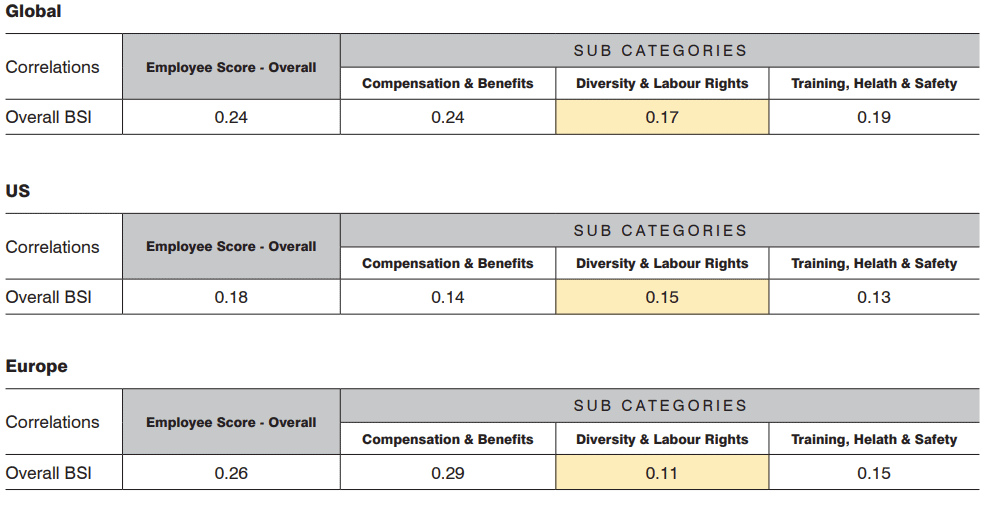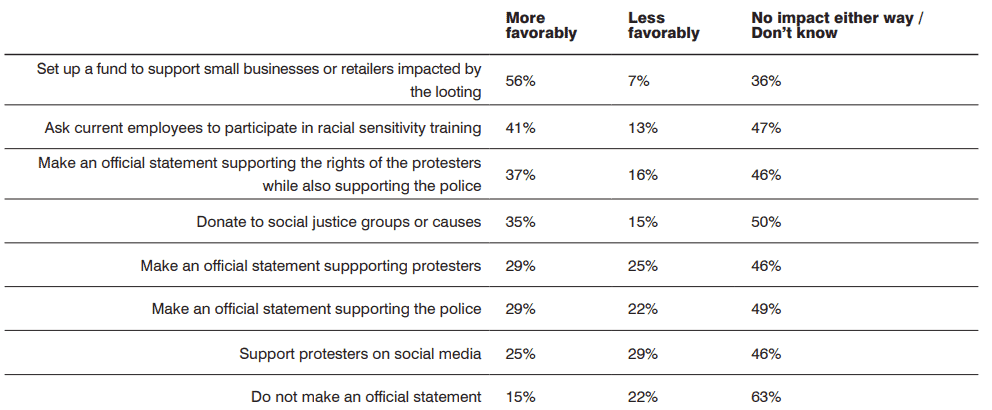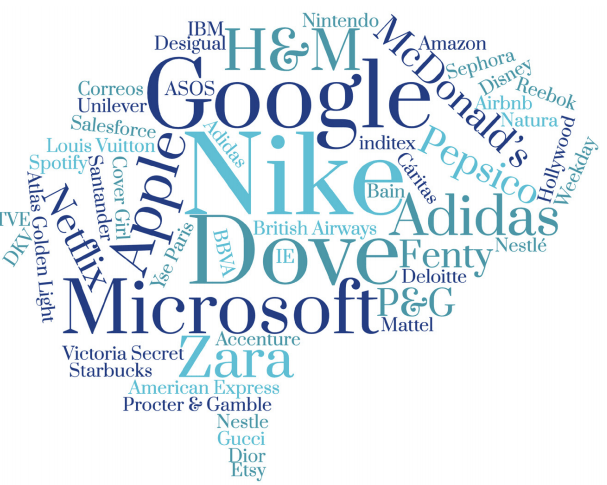Protests sparked by police brutality in the United States has led to the rise of social justice brand activism. Is fighting systemic racism the new norm for global brands?
Even when sharing the same objective, corporate brands have responded and supported the Black Lives Matter movement in very different ways. Some, more focused on statements and spots; others, on internal recruitment and training initiatives related to unconscious bias; and, a third group, on social action addressed at education or through support of black-owned businesses.
But do these initiatives and investments have a significant impact on brand value? Which specific measures related to inclusion and diversity seem to resonate the most with key stakeholders? Which specific initiatives, training related, community-related or communication-related seem to drive the most significant uplift in terms of brand value?
What Is The Impact?
In order to answer these questions, Brand Finance conducted an analysis of our database of more of 5,000 brands, correlating perceived “Inclusion and Diversity” with the brand equity metrics in our brand strength assessment model - the Brand Strength Index (BSI).
Brand equity metrics in the BSI include amongst others: Consideration, Familiarity, Preference, Recommendation, Employee Score, Analyst Recommendation, Credit Rating, CSR Scores, and Reputation. Scores for each of these inputs are then weighted and benchmarked within a competitive set for a score out of 100.
Read our article Rigour and Structure in Brand Evaluation, if you are interested in learning more about how we evaluate the strength of brands.
The employee score has three subcategories: 'Compensation & Benefits', 'Diversity & Labour Rights', 'Training, Health and Safety'. We analysed which one of them has a stronger correlation with higher Brand Strength Index scores. We found that perceived diversity and inclusion by the general public shows a correlation of 0.17 with overall Brand Strength Index (BSI) scores globally.
If we look at this correlation by geography, the importance of “Diversity” as a driver of brand strength is higher in the US (0.15), compared to Europe (0.11). In fact, in the US during 2019 diversity was a more relevant driver of brand strength than compensation or training . This might be explained by the fact that the treatment of minorities has been at the forefront of public and policital discourse.

Source: Brand Finance analysis
In 2012, The Conference Board 1 conducted a multi-year study that compared brand strength and value, as measured by Brand Finance, and sustainability performance, as measured by CSRHub2. The analysis revealed a strong connection between sustainability performance and brand value, but also, that the main aspects of sustainability that explained the overall correlation were, in this order:
- “Training, Health & Safety” with a correlation of 0.18
- “Compensation & Benefits” with a correlation of 0.17
- “Diversity and Labour Rights”, with a correlation of 0.15

Source: Brand Finance analysis, Gidwani (2013)
Diversity and Inclusion have become increasingly important for different stakeholders globally. The recent social conflicts sparked by the police brutality in the US, have renewed the relevance of this issue. This context, linked to the increasing demand for transparency and reporting, imposes a new mandate for global brands: design clear inclusion and diversity policies, implement them consistently, track their adoption, communicate them internally and externally in compelling, culturally sensitive and engaging ways, and report the impact of all these initiatives.
For this, it is key to monitor sentiment. We have a global market research database that tracks perceived inclusion and diversity, among other sustainability aspects, paired with brand investment. We use it to help corporations and brands make informed decisions about the impact their inclusion and diversity initiatives have on their own brand strength, the competitive landscape, and key stakeholders.
4 Ways Brands Are Building Their Perceptions Around Inclusion and Diversity
Brands have responded in a myriad of ways to the Black Lives Matter movement, with actions that are meant to “address the problem from within” or actions that are meant to “influence others”. Within the first group, we find brand management and talent management initiatives. Within the second group, we find communications and broader society driven initiatives which are meant to address the issue in society through influence or action. Let’s look at specific examples:
1. Communication-driven initiatives:
Many companies have published statements to express solidarity with the black community, including: Twitter, Netflix, Disney, Nike, Adidas, Amazon, Spotify, Microsoft and Accenture. P&G has launched a spot, “The Choice” which implores white Americans to do more against racism. The main criticism to all these “statements” or communication initiatives is that they do little to change the realities of those who are suffering from systemic racism.
2. Society-oriented initiatives:
Airbnb, Adidas, Apple, Amazon, Coca-Cola, Facebook, Nike, Uber, Warby Parker and YouTube announced during this month they will be donating significant amounts to organisations and initiatives fighting inequality and systemic racism, or have committed to award grants to black-owned businesses. These initiatives have been criticized by some experts as “corporate PR, because it transfers the responsibility of solving the problem to outside organisations” 3.
Therefore, many brands have also focused on the internal organisation. Ben & Jerry’s is mixing, as usual, brand-driven initiatives with social impact. The company names their products and their narratives around specific social or political causes. In 2019, in partnership with Advancement Project, they launched a new flavour called “Justice ReMix’d” that hoped to support grassroots organisations fighting for justice all over the country and ensuring that “everyone enjoys the sweet taste of justice.”
Some brands are focusing on a key issue too, education. Adidas announced that it would cover 50 annual university scholarships for outstanding black students over the next five years. Nike seemed to suggest that part of the $40 million it will invest over the next four years to support social justice, will also be funnelled to education initiatives.
Tomás Bulat, an Argentinian economist, on said “when you are born poor, studying is the greatest act of rebellion against the system. Knowledge breaks the chains of slavery.” 4 Spot on. Investing in the education of marginalised sectors of society, through scholarships, funding and grants, is one of the main initiatives a global corporation can undertake to achieve social justice in the long run.
3. Brand management-driven initiatives:
Within these, we find two specific clusters, some companies are conducting reviews of their brand identities or brand portfolios to evolve or remove some “brands with racist origins”, as well as some brands that have reviewed their association with social media platforms.
In the first cluster, we find brands like PepsiCo, which is now removing the Aunt Jemima brand, originated on a racial stereotype. Mars has decided to evolve its Uncle Ben´s brand for similar reasons. This type of review has reached Latin American countries too, with retailer Alicorp changing the name and image of its iconic brand, “Negrita” (little black in Spanish). The objective, in all these cases, is that the brand identity and portfolio reflect the corporate values and changing consumer expectations around equality, equity and social justice.
Some brands are looking for “partners that share corporate views and values on this subject. Patagonia has recently announced they will pull ads from Facebook and Instagram as part of the Stop Hate for Profit campaign, which asks all businesses to “stand in solidarity with [America´s] most deeply held values of freedom, equality and justice and not advertise on Facebook´s services in July.” 5 The Stop Hate for Profit Campaign is a recently formed coalition that alleges that Facebook is “complicit in spreading disinformation and fomenting fear and hatred.”
4. Talent management-driven initiatives:
Nike CEO, John Donahoe, explained in an internal memo to employees that “while we strive to help shape a better society, our most important priority is to get our own house in order.” The value of your corporate brand is at risk if your internal brand is weak and lacks credibility. It’s like a pyramid brand: big at the top but sustained by a “lie”.
Therefore, as Donahoe mentioned, it is of utmost importance to work on your internal brand as hard as you work on your corporate and product brand. This was also understood by Adidas, that announced a series of talent-related measures, promising to hire black and Latino professionals for 30% of all new positions in the US.
How are stakeholders reacting to these initiatives?
Morning Consult, a global data intelligence consultancy, conducted a survey between May 31st and June 1st 2020, among 1,990 U.S. adults, to explore reactions towards companies actions in the context of the current protest and demonstrations in US cities. Based on their research output, we can conclude:
- The single action that has most impact on favourability is to “set up a fund to support small businesses or retailers impacted by the looting” (with 56% of respondents seeing companies doing this more favourably, 7% less favourably and 36% being indifferent).
- All communications-related actions have far less impact on the percentage of people that see the company more favourably (official statements supporting protesters, police or both).
- The percentage of people that state that companies
around the subject had no impact either way range from 46% to 63%

Actions speak louder than words. Action to support the community shows more impact than official statements. Mostly, people are neutral to BLM statements. Why? Probably, because words without action feel meaningless to many.
Reactions to Brands Who Champion Diversity Inclusion
We wanted to use our database and research capabilities to explore the specific reactions of specialist audiences to diversity and inclusion initiatives taken by some of the “champions” in the field.
We selected three brands, one in the B2B space and two in the B2C space, and asked a specialist audience of 50 respondents, what they thought about Nike, Ben & Jerry’s, and Accenture`s inclusion and diversity initiatives. Selecting these three brands was no accident. All three have a strong reputation for investing in diversity and inclusion, and use this as a cornerstone of their marketing strategies.
We asked our respondents to mention the top 3 brands that came to their minds when they thought about inclusion and diversity before we exposed them to any names. The results are not surprising: more than half of the sample mentioned Nike (probably due to their famous Kaepernick campaign last year), followed by Dove (probably due to their long-running Real Beauty campaign), Google (despite the criticism the technology giant has faced in this regard) and H&M (which following the controversy after releasing an ad with a black child wearing a T-shirt with the inscription “coolest monkey in the jungle”.
Here you can see a word cloud with the results:

Out of these three champions, the most admired overall was Nike, followed by Ben & Jerry`s, then Accenture. The admiration for Nike and Ben & Jerry’s was higher in the female segment. Surprisingly, those respondents that categorise themselves as conservative or progressive, showed higher and similar levels of admiration for these brands than those that “sit on the fence”, showing that there might be an audience that is rather neutral to these issues (mostly young women). Ben & Jerry’s does better in terms of admiration among Gen Z (25 or younger) and Gen X (45 and older) versus Millennials, but they trail Nike with all audiences.
Before exposing the sample to selected initiatives by these three brands, we asked them how familiar they were with communications actions launched recently around diversity and inclusion. Levels of familiarity were highest for Nike, followed by Ben & Jerry’s. This could be explained by two factors: Nike’s massive investment in advertising and marketing, and the nature of their communications, mostly based on above the line initiatives vs. Ben & Jerry’s more niche, “grassroots” type of initiatives.
Nike fared best in terms of perceived authenticity and consistency, especially among those defining themselves as progressive. For everyone who knows the history and values of Ben & Jerry’s - the “honest brand” of Generation X - this came as a surprise. One hypothesis is that the tone and narrative of Nike have been, in the last month, more positive and more focused on what unites us rather than on actions and events contributing to the growing divide.
The narrative of Ben & Jerry’s has been riskier, choosing “politically charged” words like “dismantling” and “white supremacy”. This may hint that the “activist role” for brands implies taking a stand, but not using the same tone and tactics often employed in political circles: uniting rather than dividing and fuelling the conflict (even if inadvertently), showing direction by showing action rather than words or symbolic micro-actions, and putting people above their own interest and agenda.
When it comes to judgement on how much all of these initiatives would promote actual change, again, Nike fares best. All of these findings, indicate a strong correlation between consistent, well supported and executed campaigns around the subject, the creation of familiarity and a halo effect on the rest of the indicators.
But, how does all this translate into actual purchase behaviour? How important are inclusion and diversity when it comes to considering a purchase in these categories? When we compare inclusion and diversity considerations with price and quality, the latter appears a more of an important factor for most consumers. This is consistent with findings of other reputation studies, which show that product & services are the main drivers of reputation. Still, diversity and inclusion, as well as sustainability, have become part of the agenda, and their importance for different stakeholders is increasing.
Final Thoughts
Arguably, the most important outcome of this social movement is that multinationals have finally begun to take this subject seriously, incorporating inclusion and diversity into their management philosophy.
This situation and the varying reactions of stakeholders towards brand responses, are showing us that, at this juncture and when it comes to inclusion and diversity: facts are more important than words, the way you take a stand is as important as taking a stand – exemplifying unity and not agitation, and that you really care about people investing in what is important to them (black businesses, black education) rather in what is a purely cosmetic action. Brands whose actions are authentic and unifying will see disproportionate improvement in Brand Strength.
- The Conference Board | Trusted Insights for What's Ahead (conference-board.org[↩]
- Gidwani, Bahar (2013), “The Link Between Brand Value and Sustainability.” It can be downloaded from https://brandfinance. com/images/upload/the_link_between_brand_value_and_ sustainability.pdf[↩]
- Bensinger, G. (2020), "Corporate America Says Black Lives Matter. It Needs to Hold Up a Mirror". New York Times. It can be downloaded from: https://www.nytimes.com/2020/06/15/opinion/ black-lives-matter-corporate-pledges.html[↩]
- https://www.infobae.com/2015/01/31/1624070-la-ultima-entrevista-concedida-tomas-bulat/[↩]
- https://www.stophateforprofit.org[↩]
